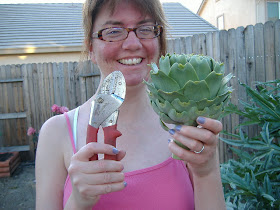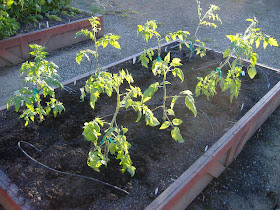 Isn't she lovely?
Isn't she lovely?Isn't that just the most wonderful shot in the world?
The world's most beautiful lady with the world's most impressive home-grown artichoke?
This photo goes in the "keeper file," for a number of reasons.
Family and friends -- I officially announce the start of ARTICHOKE SEASON in Sacramento! It actually started last weekend when we harvested the largest artichoke we have ever SEEN or GROWN off of a massive plant that is now over the fenceline.
I'll be honest. I enjoyed this artichoke for dinner last Saturday night. Of course, I did offer it to the wife, but she said no. This one was mine. I tried to get her to take it, but she would have none of it. This beauty was all for Bill Bird.
 And what a beauty it was. It was absolutely fabulous. Years of growing artichokes in large and small backyards have finally started to pay off in not only record harvests, but the most delcious and tasty artichokes I have ever tasted. Nothing, in any store, cannot compare with what we are getting in the backyard right now. In fact, with all due respect to Sacramento grocery retailers, there's no comparison at all.
And what a beauty it was. It was absolutely fabulous. Years of growing artichokes in large and small backyards have finally started to pay off in not only record harvests, but the most delcious and tasty artichokes I have ever tasted. Nothing, in any store, cannot compare with what we are getting in the backyard right now. In fact, with all due respect to Sacramento grocery retailers, there's no comparison at all.The artichokes that we are harvesting right now are not only larger than a softball, they are the most tender vegetables under the sun. The hearts of our artichokes are more than an inch thick, soft and easy to cut after steaming, and offer a taste that is simply out of this world good. Think of the best artichoke you have ever enjoyed -- double that experience -- and you might come close to what is coming out of our backyard at this very moment. Each leaf -- each tender slice of artichoke heart -- is a creamy, nutty, mouthwatering experience.
But, I must admit -- it wasn't always this way. We didn't start out with monster artichokes. We didn't start out with tender artichokes. When Venus and I started growing these wonderful vegetables in our backyard some six years ago, they were smaller. They were tougher. They had a nice taste -- don't get me wrong -- but the artichokes we were getting out of the stores were just -- well -- I'll admit it -- BETTER. And that's just not right.

And then -- one fine spring day in 2005 -- when an artichoke laden plant snapped off its base and fell to the sidewalk -- I made a vow to "do better." It's taken four years to adapt planting practices and care for plants. It's taken four years of hits and misses. It's taken four years of experimentation. But you know what? When you look at the artichokes and the production off of just one plant -- you say to yourself -- "it was well worth the effort."
Here are just a few things that I learned:
1. Artichokes need room. They need room to grow. They need room to expand. Artichokes do not do well in mixed beds. In fact, most artichokes will take over mixed beds. They'll push other plants out of the way, or worse yet, cover them, blocking off sunshine and blocking off water. If you have a small yard, like I once had, you can train your artichokes to grow up rather than out. It requires more work and effort, and lots of staking and twine, but you can do it.
2. Water consumption is key. If you find yourself with a tough artichoke, chances are, you didn't give it enough water. I'm not advising that you suddenly drown artichoke plants in a deluge of water, especially if they're producing right now. That won't help you at all. Artichokes need a regular and dependable supply of water through the winter and and spring months to produce quality fruit. They will even appreciate a regular watering schedule through Sacramento's rainy season. I'm not suggestion you turn on the sprinklers when it's pouring outside. That's overkill. But if two weeks go by without so much as a raindrop, guess what? It doesn't matter how cold it is outside -- the artichokes NEED water.
 3. Fertilization is not only encouraged, it is required. If you want big, meaty and tender artichokes with tender leaves and large, luscious hearts, you must feed them. And I've come to discover that artichokes are a lot like tomato plants in this respect. Nitrogen is good -- but they need more. Nitrogen and nitrogen only will give you large plants with limited production. If you want large plants and large production -- equal amounts of nitrogen, phosphorus and potassium are required. I normally apply fertilizers with equal amounts of all three items in the fall and winter months, and give an especially heavy dose in March, about a month before the plants begin to produce.
3. Fertilization is not only encouraged, it is required. If you want big, meaty and tender artichokes with tender leaves and large, luscious hearts, you must feed them. And I've come to discover that artichokes are a lot like tomato plants in this respect. Nitrogen is good -- but they need more. Nitrogen and nitrogen only will give you large plants with limited production. If you want large plants and large production -- equal amounts of nitrogen, phosphorus and potassium are required. I normally apply fertilizers with equal amounts of all three items in the fall and winter months, and give an especially heavy dose in March, about a month before the plants begin to produce.4. Soil is also important. Artichokes are the only vegetable that I know of that will grow in our crappy, cruddy, North Natomas clay cement. Plant them once and they'll grow year after year. They won't be the best artichokes in the world, but you will get them. But -- if you want or desire the kind of heavenly artichokes that Venus and I are experiencing today -- please give these babies what they need. Either place them in a raised bed filled with amended and composted planter mix, or amend and compost the clay soil BEFORE planting. You will be richly rewarded.
5. Artichokes do well with "organic only" gardening practices. It's taken some time to realize this, but it's true. Artichoke plants attract lots of insects. Some are beneficial. Some are not. If you spray your artichokes with any kind of bug-killer, you're going to destroy the beneficial insects that your plants will need during early and late season production. At some point however, the bad bugs will start to outweigh the good. Ladybugs can only eat so many bad critters at any one particular sitting. The more you encourage ladybug production in your yard, the better. But, if you resort to chemicals, the ladybugs you need in the spring will not be around to help you out and your plants will be quickly overwhelmed rather than gradually.
 The plants that you see in these photos? They are quite old. Venus and I invested in four plants when we created our first garden in our first Natomas home in 2003. It was an investment of less than $10. The plants have produced every year except the first. As spring turns into summer, the bugs take over and the plants die back. They cannot hack Sacramento's summertime heat -- even with our famous Delta Breeze.
The plants that you see in these photos? They are quite old. Venus and I invested in four plants when we created our first garden in our first Natomas home in 2003. It was an investment of less than $10. The plants have produced every year except the first. As spring turns into summer, the bugs take over and the plants die back. They cannot hack Sacramento's summertime heat -- even with our famous Delta Breeze.At some point this summer, the monsters that are currently growing in my planter bed will completely die back. At that point I will move in with some long-handled cutters and even a saw for the tough plants. I will cut these back to soil level. It won't look pretty. But it's something that must be done.
The artichokes, however, will survive. They have every year. At some point in the late summer or early fall, when the heat begins to break, the root systems of these plants will send up new shoots. These new shoots can either be used for next year's crop, or they can also be transplanted to a new bed (one of this year's "projects" is a new 4X8 bed for additional plants).
The life cycle begins anew. These small starters will grow exponentially through the fall and winter months and become giants in the early spring. I am already looking foward to next year's harvest, even though I have a lot more coming my way (and a few neighbors will benefit as well) in 2009.























